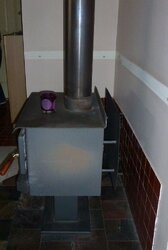Hi Guys & Hello from Perth, Australia.
I've bought a house with an existing wood burner. The back of the burner has a 'baffle' plate on it but the flue does not have any kind of additional heat shielding. When using the wood burner last winter I noted that the wall behind the burner (timber & gyproc (drywall) construction) was getting rather warm (ie damn hot !) to the touch. So this year before using it I was planning to face the wall with tiles to act as an insulator.
Does anyone have any comments or feedback on the effectiveness (or otherwise) of such an approach. I'd like to use slate tiles for that 'rustic' look but am concerned that dark tiles will simply act as a thermal energy collector and get so hot that the heat will be retained in the wall worse than before.
I could use standard ceramic tiles of a light colour but the aesthetics of such an approach would not be as pleasing as slate.
I'd appreciate any suggestions.
I've bought a house with an existing wood burner. The back of the burner has a 'baffle' plate on it but the flue does not have any kind of additional heat shielding. When using the wood burner last winter I noted that the wall behind the burner (timber & gyproc (drywall) construction) was getting rather warm (ie damn hot !) to the touch. So this year before using it I was planning to face the wall with tiles to act as an insulator.
Does anyone have any comments or feedback on the effectiveness (or otherwise) of such an approach. I'd like to use slate tiles for that 'rustic' look but am concerned that dark tiles will simply act as a thermal energy collector and get so hot that the heat will be retained in the wall worse than before.
I could use standard ceramic tiles of a light colour but the aesthetics of such an approach would not be as pleasing as slate.
I'd appreciate any suggestions.



